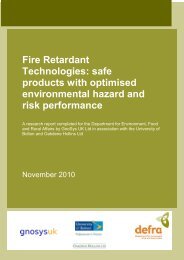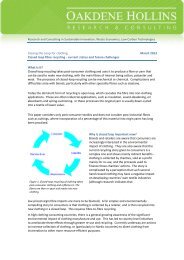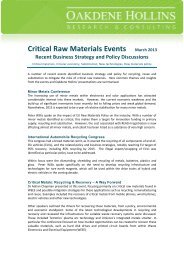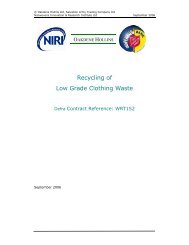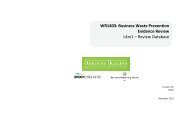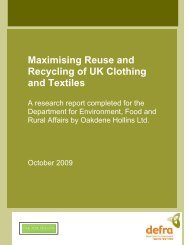Procurement and Supply Chain - Oakdene Hollins
Procurement and Supply Chain - Oakdene Hollins
Procurement and Supply Chain - Oakdene Hollins
You also want an ePaper? Increase the reach of your titles
YUMPU automatically turns print PDFs into web optimized ePapers that Google loves.
WR1403: Business Waste Prevention Evidence Review<br />
L2m4-3: <strong>Procurement</strong> & <strong>Supply</strong> <strong>Chain</strong><br />
St<strong>and</strong>ards, Environmental Management Systems (EMS) <strong>and</strong> Labelling<br />
Underst<strong>and</strong>ing the whole-life impacts of products <strong>and</strong> services can be difficult. Therefore, various<br />
st<strong>and</strong>ards, certification schemes <strong>and</strong> labels for products <strong>and</strong> services based on social, economic <strong>and</strong><br />
environmental criteria (4 p. 13) have been developed to assist in purchasing decisions. Waste prevention<br />
is encompassed in the following st<strong>and</strong>ards:<br />
St<strong>and</strong>ards for implementing an EMS (e.g. British St<strong>and</strong>ards Institution’s BS 8555 <strong>and</strong> International<br />
Organisation for St<strong>and</strong>ardisation’s ISO 14001 (2 p. 25)<br />
European Community’s Eco-Management <strong>and</strong> Audit Scheme (EMAS) (4 p. 62) (2 p. 25)<br />
BRE’s British Environmental <strong>and</strong> Sustainability St<strong>and</strong>ard 6001 (83 p. 2)<br />
Canadian Environmental Choice Programme (21 p. 85)<br />
Green Seal Environmental Partners (21 p. 85)<br />
Manuals of ‘environmentally-friendly’ products <strong>and</strong> services developed by local authorities (97 p.<br />
18).<br />
Similarly, labels such as the Japanese Eco-Mark (21 p. 85), the European Union’s Ecolabel (2 p. 25) or the<br />
Canadian Environmental Choice Programme’s Eco-Logo label (19 p. 31) may play an important role in<br />
procurement. 2003 research on nine retail chains in Italy accounting “for more than 80% of the retailing<br />
sector” found that “the large majority of the interviewed companies use the eco-label as an effective <strong>and</strong><br />
useful assessment tool for their suppliers, in order to select them for their vendor-list” (21). This suggests<br />
that purchaser power can drive suppliers to work towards achieving the EU Ecolabel.<br />
We should note that EU Ecolabel is a generic approach, but that there are many more product <strong>and</strong><br />
sector-specific ‘eco’ labels in operation, often tackling different impacts. For example, in textiles, in<br />
addition to EU Ecolabel, Oekotex, GUTS <strong>and</strong> Bluesign are commonplace but have varying relevance to<br />
waste prevention.<br />
St<strong>and</strong>ards, codes <strong>and</strong> labels can also be adopted by the purchasing organisations themselves, again with<br />
the aim of facilitating the sustainable procurement process:<br />
As part of its EMS, an Oregon (USA) manufacturer <strong>and</strong> direct marketer of period-authentic lighting<br />
<strong>and</strong> house parts Rejuvenation “had an employee task force examining vendor packaging” (17 p. 10).<br />
In 2001, the London Mayor’s Green <strong>Procurement</strong> Code was launched with Regional Development<br />
Agency funding, although the initial focus was on encouraging materials with high recycled content<br />
rather than waste prevention (97). The Code was re-launched in October 2007 with a new emphasis<br />
on “management <strong>and</strong> behaviour change” <strong>and</strong> a widened remit to “reflect the broad range of<br />
environmental considerations in procurement, from energy efficiency to the use of sustainable<br />
natural resources <strong>and</strong> from buying recycled content products to minimising vehicle emissions”. a<br />
In summer 2010, Action Sustainability launched BS 8903: Principles <strong>and</strong> Framework for Procuring<br />
Sustainability, described as ‘the world's first st<strong>and</strong>ard for sustainable procurement’ b .<br />
The modules L2m4-1: St<strong>and</strong>ards <strong>and</strong> L2m4-2: Labelling provide more information in this area.<br />
Tools<br />
Successful business <strong>and</strong> procurement, the 2010 SDRN report introduced above identifies several tools<br />
used in the public sector such as “supplier assessment questionnaires, life cycle assessment tools, <strong>and</strong><br />
mathematical modelling” (5 pp. 7-8). However, few were used in the private sector <strong>and</strong> no evidence was<br />
found of waste prevention resulting from their use.<br />
a http://www.greenprocurementcode.co.uk/?q=node/75<br />
b http://www.actionsustainability.com/<br />
34 For Defra



